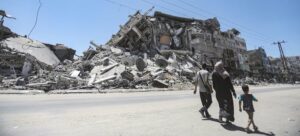Only a political solution will end the “senseless and costly cycles of violence” between Israelis and Palestinians, UN Middle East envoy Tor Wennesland said at a briefing to the Security Council in 2021.
By Thalif Deen
UNITED NATIONS (IDN) — The Israeli-Palestinian conflict, which dates back to 1948, is one of the longstanding disputes which has remained unresolved between the two warring parties.
A possible diplomatic solution to the ongoing crisis has also reached a virtual dead-end at the United Nations, whose primary mandate is the maintenance of international peace and security.
As a cynic once remarked, the Palestinians and Israelis seem to agree only on one thing: that the other party is at fault. But several international efforts to break the deadlock have proved futile—and the conflict rages on, resulting in thousands of deaths and widespread destruction by Israeli airstrikes.
However, a new proposal for the creation of a Holy Land Confederation, the product of two years of discussions with Palestinians and Israelis, is currently doing the rounds both in the Middle East and at the United Nations. The proposal is primarily based on the 2003 Geneva Accord, a peace plan drawn up by prominent Israelis and Palestinians.
The 100-page confederation plan is the brainchild of Yossi Beilin, a former senior Israeli official and peace negotiator who co-founded the Geneva Initiative and Hiba Husseini, a former legal adviser to the Palestinian negotiating team.
According to a February 7 Associated Press (AP) report from Jerusalem, the plan includes “several controversial proposals, and it’s unclear if it has any support among leaders on either side”.
“But it could help shape the debate over the conflict”—and was presented to a senior U.S. official and the UN Secretary-General last week.
The plan calls for an independent state of Palestine in most of the West Bank, Gaza and east Jerusalem, territories Israel seized in the 1967 Mideast war. Israel and Palestine would have separate governments but coordinate at a very high level on security, infrastructure and other issues that affect both populations, said AP.
The plan would allow the nearly 500,000 Jewish settlers in the occupied West Bank to remain there, with large settlements near the border annexed to Israel in a one-to-one land swap.
“Settlers living deep inside the West Bank would be given the option of relocating or becoming permanent residents in the state of Palestine. The same number of Palestinians—likely refugees from the 1948 war surrounding Israel’s creation—would be allowed to relocate to Israel as citizens of Palestine with permanent residency in Israel,” according to AP.
Asked for more details, Liv Halperin, Director, Research and Policy at the Tel Aviv-based Economic Cooperation Foundation (ECF), a think tank that coordinated the meetings between Palestinian and Israeli experts in the past two years and contributed to the drafting of the model, told IDN the Holy Land Confederation is not a substitute for the two-state solution.
“It is rather a means of facilitating a two-state solution, providing a new framework for the negotiation of a permanent solution between the two sovereign states of Israel and Palestine.”
“We propose a model based on cohabitation and cooperation between two sovereign states rather than a model, such as the classic two-state solution, which is based on separation. We hope that such a model will enable both Palestinians and Israelis to break through the ongoing deadlock in the peace process,” she added.
She pointed out the proposed Confederation makes Jerusalem the capital of both States and a partially open city and allows an agreed-upon number of citizens from each state to live in the other state as permanent residents.
It thereby eliminates the need to forcibly evacuate tens of thousands of Israelis, a major obstacle to reaching a peace agreement.
“Ours is a flexible and pragmatic model, with both parties free to withdraw from the confederation or to proceed toward even more integration if they so desire.
“Our model offers a horizon for the long-term realization of both the Palestinian aspirations for national self-determination in an independent and sovereign nation-state and the mainstream Zionist vision and ethos,” she declared.
Excerpts from the interview:
Q: Has the proposed plan been endorsed or supported by either the Israeli government or the Palestinian Authority? And what about Hamas? Any reactions from any of these parties?
A: Not yet. The plan will hopefully be presented to Palestinian and Israeli authorities in the coming weeks.
Q: Have you played this by the five veto-wielding permanent members of the UN Security Council—the U.S., UK, France, Russia and China—or do you have any of their blessings?
A: The plan has just been presented to the U.S. administration and will be presented to other countries in the next few months.
Q: Depending on the reactions of the Israelis and the Palestinians, would you amend or revise the proposal as it stands now?
A: The model is designed to be both pragmatic and flexible; we hope that both parties will draw inspiration from this model, which can of course be adjusted.
Q: Are you planning to submit the proposal to the UN Secretary-General? If so, what was his reaction?
A: On February 11, our delegation met UN Secretary-General António Guterres and four of his advisers in New York to present the model. He listened with great interest.
Q: If the proposal is eventually accepted by both parties, do you think it would be necessary to seek ratification by the 193-member General Assembly and the 15-member Security Council, both of which have been involved with the Palestinian issue since its inception?
A: It is too early to say. At this stage, ours is a framework that could provide a path forward to solving the conflict. [IDN-InDepthNews – 16 February 2022]
Photo: A building damaged by an Israeli airstrike amid a flare-up of Israeli-Palestinian violence in Gaza City. Credit: UNRWA/Mohamed Hinnawi


